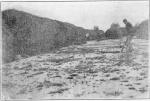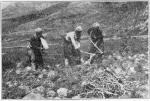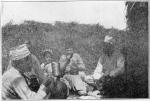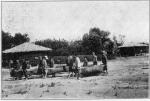John Uri Lloyd, 1929: Licorice.
Scanned version copyright © 2000–2024 Henriette Kress.
John Uri Lloyd, Cincinnati, Ohio. - Reprinted from The Eclectic Medical Journal, December, 1929.
My thanks are due to Professor Thomas H. Norton for introducing me to the manufacturers and dealers in licorice in and about Smyrna. Credit for information relative to manipulation, as well as statistics, is due to Marenti & Co., Smyrna, and MacAndrews & Forbes, Sokia. The accompanying photographs were also taken by me in the licorice industries of these firms. Paper was written from notes of my travels, 1906.
History.—The licorice plant abounds over an extensive area of the warm portions of Europe, including some of the Mediterranean islands, thence into Asia, where it is abundant in great sections of Turkey and Persia. Many varieties are recognized by botanists, but the drug of commerce is yielded by two principal varieties of Glycyrrhiza glabra, recognized as official. The plant has been known and used from antiquity to the present time.
Theophrastus refers to a sweet Scythian root, growing near the lake, Maeotis (Sea of Azov), used in cough and pectoral affections. Dioscorides gives it a place, describing two varieties of the plant, while the Roman writers, Celsus and Scribonius Largus, call it the sweet root, Radix Dulcis. Pliny, of course, met it in the sections about his own country, and describes is as native to Cilicia.
Not only does licorice grow wild throughout large sections of the world, but is also cultivated. However, it is so abundant in its native land, where labor is cheap, as to render its cultivation in most other sections unprofitable.
There can be no more aggressive weed in any locality than is the licorice plant in the rich bottom lands of Turkey. Immense amounts of the drug are exported from Smyrna and large quantities of licorice extract (paste) are made in both Smyrna and Sokia. Having made a study of licorice in its homeland, where it has existed from time immemorial, I shall limit my remarks to conditions that exist there.
The history of Smyrna licorice is briefly given as follows: Over half a century ago, a traveler recently returned from Turkey, in a lecture before a London audience, referred to the enormous growth of licorice in the valleys of the Meander and Hermus in Asia Minor. This came to the attention of the MacAndrews, a Scotch firm of ship owners whose steamers were engaged in carrying licorice, licorice paste, oranges, etc., from Spain. MacAndrews sent a man named Clark (whose wife still lived near Smyrna in 1906) to investigate. He found a native (Graeco-Italian) pasteworks operating at Cutzarlee. Mr. Clark gave a most favorable report to his employers, who started a factory at Sokia, across the Meander valley from Cutzarlee. The root was so abundant and labor so cheap that it cost but one-tenth the price the Spaniards and Italians paid in their countries. Consequently, the profits were enormous, and from this beginning, which has made great fortunes for the investors, the licorice industry of Turkey has developed.
Description.—The licorice plant prefers the richest land and covers vast areas of the bottoms about the rivers, Hermus and Meander. It not only covers the valleys, but creeps up the hillsides. The rich meadows about the ancient cities of Priene and Magnesia are threaded with licorice. It wedges itself between the stones of the ancient roadway of the Greeks. The wheat fields of the adjacent valley are no sooner plowed than its bean-like vine heads appear. The stones of the mountain slopes collect earth which also harbors the weed, for in this country licorice is a weed that cannot be exterminated. Naturally, only soft earth can yield a profitable return to the digger.
In the licorice lands every crop has licorice as a companion. It is probable that this has been the case throughout the period that marked the rise and fall of empires and of recurringly destroyed and ever-crumbling cities, such as Ephesus and Priene, whose rich valleys have been cultivated from the beginning of history, and are yet so fertile as to make one question the possibility of their exhaustion. In this home of marvelous fertility the licorice plant is master. Yet it is a kindly master, for in these very fields are grown such crops of wheat, such vegetables and fruit as to astound one who contemplates the fact that since the days of antiquity these fields have, without fertilization, fed hordes of Roman, Greek, Turkish and other nations, as empires successively rose and fell. In fields about the river Meander, thickly threaded with licorice, near the ancient city of Priene, I stood in wheat which, thick as grass, rose above my head.*
* I can but question if the leguminous plant, licorice, may not have the power of harboring colonies of bacteria to fix atmospheric nitrogen as a food. This, it seems to me, needs to be investigated.

 Gathering Licorice.—In the fall the plant dies to the ground, but the root lives over the winter. The undried stem stalk is often the size of the wrist, or even larger. From its crown dips a root that runs down, in accordance with the soil, from two to even five or six feet. From this tap root radiate horizontal branches that extend several feet outward. All parts of the underground portion are marketable.
Gathering Licorice.—In the fall the plant dies to the ground, but the root lives over the winter. The undried stem stalk is often the size of the wrist, or even larger. From its crown dips a root that runs down, in accordance with the soil, from two to even five or six feet. From this tap root radiate horizontal branches that extend several feet outward. All parts of the underground portion are marketable.
The Licorice Digger.—From the station, Sokia, and other licorice centers in the licorice season one may see at daybreak the native diggers, mounted on donkeys, striking out into the valley of the Meander. They ride from six to eight miles to suitable locations and begin their task. A heavy grubbing hoe is employed. The digging of each tap root requires the sinking of a pit in the earth from which deep furrows must be dug to procure the radiating side roots. As the diggers proceed the earth behind them is thus cast into uneven hillocks and trenches. At nine o'clock the lunch of bread and a bit of sweet cheese, perhaps a few olives or a little molasses, is eaten. Never any wine in this land of grapes and wine, for to Turkish people wine or other alcoholic drink is forbidden by decree of the Koran. Again they patiently work until evening, partaking of no midday meal. Finally the day's product is loaded on the donkey, and, when the distant station is reached, weighed and paid for. The maximum of a day's yield is fifty cents; sometimes it is as low as twenty cents. Out of this the laborer lives, furnishes and feeds the donkey and supports his family.
A field in the valley of the historic Meander, dotted with licorice diggers and their donkeys, is picturesque in the extreme.
The digger does not exterminate the plant. The runners are furnished with buds, and all the root fragments left in the ground throw up new sprouts. In three or four years the same earth is again ready for the grubbing hoe, the patient Turk is again ready for his task. Should the ground be cropped in the meantime, the licorice still thrives, a live and let-live weed.
The Root.—The licorice root is dirty brown and very scraggly. It makes a tortuous, unsightly heap when piled by the diggers in good-sized heaps. These stacks are forked over into new locations from four to six times. Especially is this necessary during damp weather. When dry, the root is thrown into great heaps, thousands of pounds each, and, if possible, roofed over or covered with canvas.
Manipulation.—The root is now transferred to the factory and either ground coarsely and extracted or baled by pressure and exported to America, where the customs' duty prevents the profitable entrance of extract. For pharmaceutical purposes and in other directions where nice appearing root is preferred, the heaps are sorted by girls, women and boys, who select the long straight roots and cut them into proper lengths. These are sorted and wired into large bundles, to be re-bundled into smaller bundles in the country of their destination. The women earn from twenty to thirty cents a day, but are diligent and happy. In the station near Magnesia I observed twenty-five or thirty women sorting the root, but in Sokia saw only extract manipulation and baling for American export.
Taking it all in all, the Turkish licorice industry, so far as the drug is concerned, consists simply in the collecting of a wild root that grows in lavish abundance over an immense area of Asia Minor. It gives employment to a small army of very poor peasants, who, by hard labor, exist in the most frugal manner.
There seems no probability of the exhaustion of this industry, notwithstanding the immense amounts demanded for export and consumed in the making of licorice paste to be used in the European and American tobacco industries.
 Licorice Extract.—This is known as licorice paste, and is made in the most primitive manner. The drug is coarsely ground and mixed with water in iron or copper tanks and is then boiled. The decoction is drawn off, the dregs again covered and boiled as before. The dregs are then squeezed by hydraulic pressure. The decoctions are mixed and boiled in tanks until reduced to the consistency of tar, then carefully concentrated over a slow heat to a thick, black magma. This is drawn off and poured hot into paper-lined wooden boxes. These boxes hold about three hundred pounds of the paste, which, when finished, contains 25 to 26 per cent. moisture. The root produces from 40 to even 50 per cent. of its weight of paste. To concentrate beyond this point without a vacuum apparatus injures the product by reason of the high temperature. The use of the vacuum, which reduces the moisture to 20 per cent., is a feature of some establishments.
Licorice Extract.—This is known as licorice paste, and is made in the most primitive manner. The drug is coarsely ground and mixed with water in iron or copper tanks and is then boiled. The decoction is drawn off, the dregs again covered and boiled as before. The dregs are then squeezed by hydraulic pressure. The decoctions are mixed and boiled in tanks until reduced to the consistency of tar, then carefully concentrated over a slow heat to a thick, black magma. This is drawn off and poured hot into paper-lined wooden boxes. These boxes hold about three hundred pounds of the paste, which, when finished, contains 25 to 26 per cent. moisture. The root produces from 40 to even 50 per cent. of its weight of paste. To concentrate beyond this point without a vacuum apparatus injures the product by reason of the high temperature. The use of the vacuum, which reduces the moisture to 20 per cent., is a feature of some establishments.
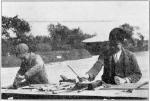 Licorice paste is of a dark—nearly black—color, has a slightly licorice odor and a lingering, intensely sweet taste. It is largely soluble in water, and especially so in alkaline saliva. The paste made in Turkey is mostly exported to European countries, where it is used mainly in the tobacco industry. The American duty on the extract necessitates the exportation of the crude drug to America, where the paste is then manufactured. In questioning the extract makers I was told that glycyrrhizin did not answer the purpose of the extract. It did not carry the full sweeting qualities nor did it possess the flavor of the drug. Its manufacture had, therefore, been abandoned in favor of the established process of licorice extract.
Licorice paste is of a dark—nearly black—color, has a slightly licorice odor and a lingering, intensely sweet taste. It is largely soluble in water, and especially so in alkaline saliva. The paste made in Turkey is mostly exported to European countries, where it is used mainly in the tobacco industry. The American duty on the extract necessitates the exportation of the crude drug to America, where the paste is then manufactured. In questioning the extract makers I was told that glycyrrhizin did not answer the purpose of the extract. It did not carry the full sweeting qualities nor did it possess the flavor of the drug. Its manufacture had, therefore, been abandoned in favor of the established process of licorice extract.
 Statistics.—Smyrna is the principal port of export for both licorice root and paste. The American Tobacco Trust controls the larger acreage of licorice land in the vicinity of Smyrna, and also in other sections of Asia Minor. Its aggressiveness has largely resulted in the destruction of the business of the licorice dealers who formerly supplied the drug and its extract.
Statistics.—Smyrna is the principal port of export for both licorice root and paste. The American Tobacco Trust controls the larger acreage of licorice land in the vicinity of Smyrna, and also in other sections of Asia Minor. Its aggressiveness has largely resulted in the destruction of the business of the licorice dealers who formerly supplied the drug and its extract.
Licorice paste contains 25 per cent. moisture.
Root yields 40 per cent. paste.
Paste yields 21 or 22 per cent. glycyrrhizin.
Sells at thirty-four shillings for 112 pounds delivered at Liverpool.
Men dig one hundred pounds per day.
Diggers' wages twenty-five to thirty cents.
Lost in drying, 50 per cent.


